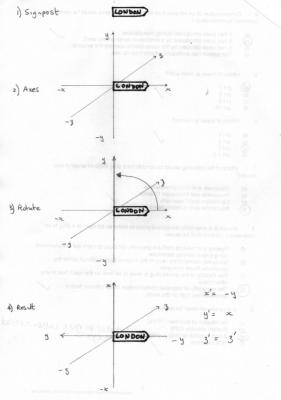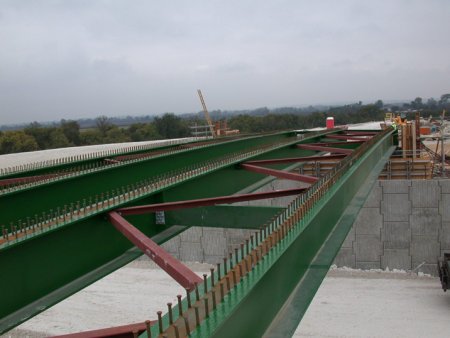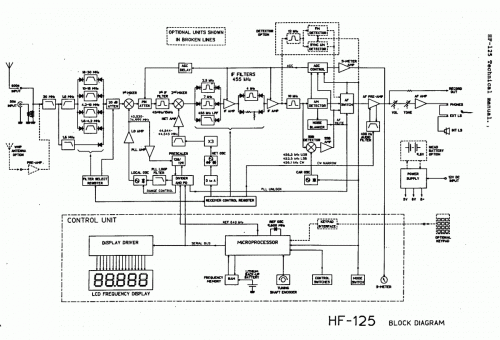-
Posts
18270 -
Joined
-
Last visited
-
Days Won
104
Content Type
Profiles
Forums
Events
Everything posted by studiot
-
You haven't finished manipulating the integrand. [math]\frac{{dy}}{{dx}} = y\cos (x)[/math] rearrange to separate variables as ajb [math]\frac{{dy}}{y} = \cos (x)dx[/math] Integrate [math]\ln (y) = A\sin (x) + B[/math] take exponentials of both sides [math]\exp (\ln (y)) = A\exp (\sin (x) + B)[/math] That is [math]y = C{e^{(\sin (x) + B)}}[/math] Now substitute for y and x
-
I'm sorry but I must ask to to rephrase this as it makes absolutely no sense to me whatsoever. The first sentence makes sense and in arithmetic the answer is no. However the second is not complete since the question how many requires counting or enumeration and is only complete with how many of what? There is indeed scope within set theory to address this and the theory straddles that part of logical thinking common to both mathematics and philosophy. For instance the question How many sheep are in a field of 10 ewes and 5 lambs? This is discussed in one of my books on the subject, I will try to look it out.
-
Do you understand the difference between the general solution of original differential equation and the general solution of the the problem which includes the above boundary condition? Knowing this will help you make sense of ajb's hint Should this be posted in homework?
-
Gravity affects both fermions and other particles with mass. Pauli only affects (applies to ) fermions.
-
Most mathematics starts with set theory. A set is the posh mathematical name for a collection of (mathematical) objects, although there is some argument about this and the words class and type have also been used. By itself a random collection of objects is pretty uninteresting and useless, mathematically. So we place restrictions on the objects. Usually we require that all the objects are of the same sort (eg all numbers, all vectors all angles ) We often require that there is only one appearance (instance) of any particular object. But this is still pretty boring So we set down a list certain properties that all our object must possess. Obviously there are many possible lists so centuries of thought has gone into what should be on a particular list. We call such a list 'the axioms of our set' and a space is the set of all objects that obey they axioms. So a vector space is the set of all objects that obey the (8 or 9 ) vector space axioms. We call these objects vectors. This gives the set some useful structure and justifies introducing a new word (space). This structure allows us to perform mathematical operations on the vectors in the vector space, which is why we go to all that trouble to spout all that terminology. There are many different vector spaces and that part of mathematics devoted to the study of these is called linear mathematics. This is still probably the largest part of mathematics since most applications are linear. You have a knack for digression by introducing new words that you do not fully understand. So it was good that you acknowledged this. This post was designed to help there. You also made some very good comments on my post 43 (your post 46) If you like this post I will return to the subject of momentum, conservation and invariance and those replies.
-
So don't squabble with 'Them', whoever 'They' are. ajb has shown you several useful pieces of mathematics, including one which you may not have appreciated. There are many 'types' of calculus. One of these, the calculus of variations ajb mentioned, underlies the Finite Element Methods you brought up. You have managed the beginning of an intelligent discussion about momentum with me, but for some reason seem not to want to continue. Here is a history My post 5 (I apologise for calling it post 3 before by mistake) My post 19 a reminder Your post 22 as reply sensible enough that I nearly gave a +1 (perhaps next time). My post 23 developing the discussion about momentum. Your post 24 quoting my post 5 again, but not replying further to it or post 23. My post 39 another reminder Your post 40 quoting my post 39. Hilarious, but containing no technical content.
-
Studiot enters SF website, Checks very carefully in case capiert has answered his post. Notes that several others have been answered but not his. For the second time. Concludes that capiert would rather continue squabbling with others than proceeding with the one conversation demonstrating rationality. Leaves SF website in disgust.
-
Congratulations, you seem to have applied you mind to the substance of what I was saying about conservation. Some points arising My instinct would say, temperature (ruffly, no calibration, nor etc). No, the momentum is zero by definition of the word stationary. As an aside, What is the temperature of a single isolated particle? The stagnation point has lost a significant part of its momentum, to other parts of the fluid. ? Or it's lost that speed into rotation, vortexes, whirlpools. The question is naturally, to the slow down (loss). The whirls stop. Where did the speed go? Especially if it is not (gone) into heat (random) motion. I say, 2 colliding particles that stop (not bounce), becoming 1 total (mass, like bread doe) have cancelled their opposite speeds. Result, (& I know you're not going to like it) momentum cancelled (=destroyed); Why wouldn't I like it? That is exactly what happens. Play a horizontal fire hose jet onto a vertical wall. There is a stagnation point at impact where the fluid horizontal momentum is destroyed. However the energy is not destroyed since the fluid still possesses the potential energy due to pressure. This pressure is known as the stagnation pressure. You should note in this that energy and momentum are different types physical entities. Energy is a scalar and thus has no direction. Momentum is a vector and thus has direction. Whilst horizontal momentum is destroyed, vertical momentum is created. The condition for the destruction/ creation of momentum is the application of an external force. If you like it is diagnostic of such application.
-
First you fail to reply to my polite post#3 Now you are insulting me by including me in some claimed universal failing, (which I'm sure others don't accept either).
-

Can't wrap my head around pressure and flow rates....
studiot replied to phdinfunk's topic in Classical Physics
What John was showing you is that the flow rate is not controlled by the regulator valve. It is controlled by whatever you are feeding the gas into. Connect some pipework etc Set the gas pressure valve to any value you like Measure the flow rate Unconnect the pipework and connect different pipework Measure the flow rate again, with the same setting on the gas pressure valve. The flow rate will be different. I have already told you how to control the flow rate, Did you look it up? You connect another device (not the pressure regulator). Once such is called a metering pump. These are extensively used in industry and hospitals. -

Can't wrap my head around pressure and flow rates....
studiot replied to phdinfunk's topic in Classical Physics
I rarely heard so much rubbish. I can drive 50 miles whatever speed I have on my speedometer, it just takes a different itme at different speeds, since distance (in miles) = speed (in mph) x time in hours In the same way a pressure regulator regulates pressure which is not measured in litres per minute. I took the effort to put some proper thought into replying to your added question, but you obviously haven't done me the same courtesy. -

Can't wrap my head around pressure and flow rates....
studiot replied to phdinfunk's topic in Classical Physics
Good job you are not a diver, then. Here is example 1 A scuba diver has a gas tank a pressure regulator and a breathing mouthpiece. Now as the diver performs various activities he breathes a variable quantity of gas, the harder he swims the more he needs to breathe. But it is vital for the life of that diver that the pressure he breathes that variable gas flow at is set at fixed value by the regulator. That fixed value is equal to the pressure of the surrounding water he is swimming through. Now this was a simple system Tank - pressure regulator - diver. Example 2 is a gas burner on a camping stove. Here the system is one item more complicated. Tank - regulator - burner manifold - exhaust. I don't know if you understood the comparison to electrical circuits but the introduction of the burner manifold is the gas equivalent of introducing a large value resistor in series so that it swamps the load and turns a constant voltage supply into effectively a constant current one. In this situation the manifold characteristics may well allow a pressure setting at the regulator to produce a set flow rate. But we have not been told the characteristics of this manifold and in any case I did say that it is the characteristics of this extra item that actually controls the flow, in conjunction with the set pressure. You would not ask What speed do I need on my speedometer to drive 50 miles? The question is incomplete. -
Which part of their anatomy would they grow them on so we could all become Avatars?
-

Can't wrap my head around pressure and flow rates....
studiot replied to phdinfunk's topic in Classical Physics
I thought the answer was quite specific. You can't do this. -

Quantifying the Physical Property of Direction.
studiot replied to steveupson's topic in Speculations
I am not sure which or whose example you are referring to but you have been told many times by several mathematicians of world renown that the standard geometry of the sphere is Euclidian. Euclid himself did some of it. You were also told that the Cartesian geometry I offered in my example in post231 is also Euclidian, although Euclid never did any of this. I am not going to go there again. I recently asked you not to introduce spurious terms you do not understand. So please ask if you need to know if something is Euclidian or non Euclidian. Nor , I think, do you understand the word 'commute'. It does not mean 'shuttle back and fore between frames or coordinate systems' I means that you get the same result for two operations A and B whichever order you perform them in. I don't see two operations here. Now I clearly specified a fixed object However, as you say, this seems to have brought out into the open your 'hopeful insight' that not only does is length invariant but also something you call direction. You could have started this thread with that proposal. -

Quantifying the Physical Property of Direction.
studiot replied to steveupson's topic in Speculations
So let us study the subject of invariance further, particularly in relation to magnitude, direction and since you have introduced it, orientation. When Studio T was first formed we did a lot of animations., but I no longer have the resources to do these. Happily there is not need, as Klaynos observes. Pencil and paper will suffice. So start with a well fixed signpost as in Fig1. Add a Euclidian coordinate system as in Fig2. Since we are looking for quantities that are the same in all coordinate systems any system will do so I have picked a convenient one with the signpost aligned along the positive x axis. Now consider a 90o rotation of the axes as shown in Fig3, around the z axis. Note the signpost does not move and continues to point in its original direction. The transformation is shown in Fig4, including the mathematical formulae. It is immediately seen that the signpost is now pointing in the negative y direction so neither direction nor orientation are preserved. So they are not invariants in Euclidian systems. But what about magnitude? Well suppose we use the standard measure [math]L = \sqrt {{{\left( {{x_2} - {x_1}} \right)}^2} + {{\left( {{y_2} - {y_1}} \right)}^2} + {{\left( {{z_2} - {z_1}} \right)}^2}} [/math] and allow the sign to be 10 units long so in Fig2 it stretches from x1 = 0 to x2 = 10 y1 = 0 to y2 = 0 z1= 0 to z2 = 0 [math]L = \sqrt {{{\left( {10 - 0} \right)}^2} + {{\left( {0 - 0} \right)}^2} + {{\left( {0 - 0} \right)}^2}} = 10[/math] and in fig4 x'1 = 0 to x'2 = 0 y'1 = 0 to y'2 = -10 z'1= 0 to z'2 = 0 and the measure is [math]L = \sqrt {{{\left( {\left( { - 0} \right) - \left( 0 \right)} \right)}^2} + {{\left( {0 - 10} \right)}^2} + {{\left( {0 - 0} \right)}^2}} = 10[/math] showing that, at least for this transformation, length is invariant. -

Quantifying the Physical Property of Direction.
studiot replied to steveupson's topic in Speculations
+1 -

Quantifying the Physical Property of Direction.
studiot replied to steveupson's topic in Speculations
I'm sorry this makes me think you are just pulling technical sounding words out of the air and stringing them together. Please try to understand their meaning, and then use them properly. It really does aid communication. Invariant means, well that it does not vary, in any coordinate system. You cannot have something invariant in only one coordinate system. -
A good deal of valuable input, particularly this +1 But please note the OP drawing has the electrodes entirely encased in insulation.
-
Nor have I. But an electron is not an atom and this thread is entitled the frequency of a single atom, which does not vibrate in the circumstances you outline.
-
Thanks, looks pretty much as I suggested. Only difference is that the deck seems to have taken the bearings with it on the collapsed span, pulling them right off the bearing shelf. Perhaps they were seized or that was the fixed end. The bearings can be seen as blocks under the main beams on the span still standing
-
I still await Daedalus confirmation of more detail but here is some more information on the type of bridge shown by arc. Bridges constructed as a concrete deck slab in a longitudinal arrary of steel I section beams are usually monolithic construction. The top and bottom flanges of the main I section girders are not usually of the same size because the top (compression) flange uses the deck slab as well (hence monolithic) In order to transfer the horizontal shear from the steel flange into the deck shear connectors or studs are welded onto the top of the flange as in the picture of such a bridge under construction. This means that the tops of the beams are pretty rigidly held in a very stiff matrix. Wacking the bottom flange with a truck cause rotation at the bottom, but the top can't go anywhere. So if you now prop one flange against the next etc as in your seismic stiffening you run the risk of the bottom flange shearing clean off rather than buckling/twisting sideways as daedalus' bridge upon impact. In fact I'm not at all sure what would be achieved by those concrete props. Tall steel girders have slended webs in substantial vertical shear, maximum over the supports. As such they are prone to compression buckling at these points and are usually (should be) stiffened by perpendicular strips of stell welded in near the supports. These are called web stiffeners. Additional ones of these will help with vertical seismic activity. Horizontal props just above the bottom flanges will not. In fact , since the props are concrete, they cannot take tension and will loose any effect if there is any horizontal seismic movement or oscillation.. So I suspect they are of a political design, rather than an engineering one. The diagonal bracing seen in my picture are there for stability, prior to the deck slab being cast, ie erection purposes, not structural stability during the service life of the bridge.
-
Two suggestions to help. Firstly a good textbook at introductory level is the TEC level 2 book Radio Systems level2 by DC Green. Followed by the level 3 Book strangely enough called Radio Systems level3 by DC Green. Secondly get used to reading and understanding Block diagrams They are really useful. I wanted to draw one to go with my original reply, but I am sorry I did not have time and the moment has now passed. https://www.google.co.uk/search?q=block+diagrams&hl=en-GB&gbv=2&source=lnms&sa=X&ved=0ahUKEwjehvPRw-7MAhXGD8AKHQGXDlEQ_AUIBA Some good examples come from this site http://ukradio.info/Degen/ such as this one for a radio receiver. Ask anything about it.
-
Ear wax? 45oC Candlewax is 37oC Sealing wax is 45oC I don't understand, how can it be hard at 45oC if its melting point is 38oC?
-
Please note that conductivity has nothing whatsoever to do with displacement current, which the OP was asking about. That is due to the capacitive effect between the insulated (not 24 carat gold) electrodes. However since the OP will not tell us more about the complete circuit, including earthing, upon which the displacement current depends, nothing more can be deduced.




